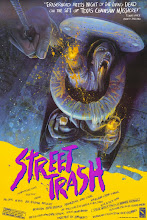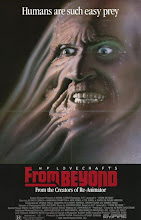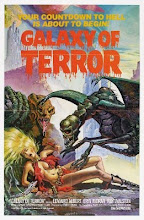Deep space, late 23rd Century:
For the sake of his bloated vanity, the ship's captain has just thrown away the lives of his entire crew (and a brand new Constitution Class Heavy Cruiser) in a military engagement so futile it made the Kobayashi Maru look winnable. His captain and fellow crewmen all dead, the sole survivor of this appalling catastrophe is a plucky young Starfleet ensign, fresh out of the Academy. He is adrift amongst the blasted wreckage of the ship, surrounded by the frozen, mangled corpses of the friends and comrades who served alongside him. Ice crystals glitter on their frigid, spilled entrails. Their torn, burnt faces will forever wear the screams and prayers of their anguished final moments. Glistening maroon sculptures of hardened boiled blood jut from gaping wounds, erupting from torsos that have violently burst open under explosive decompression.
The shit-stink in his nostrils is a constant reminder that he's fouled his EV suit. Distant echoing voices that aren't really there and a sudden migraine like an ice-knife into his brain make him painfully aware that the suit's oxygen supply is about to run out. His vision fails, he gasps convulsively for the last stale fumes of air.
No Academy simulation could prepare anyone for this reality, let alone a naive, youthful junior officer. Overwhelmed by the hopelessness of his situation and the combat horrors before him, he begins to weep. Uncontrollably. Sobbing for the light-year-distant family who he knows he will never see again.
Now, out of nowhere, a familiar and sickening feeling. The nauseating, excruciating pain of molecules slowly ripping apart. Starting like pins and needles in the bone marrow and building to a nerve shattering agony that consumes his entire body. Our valiant young ensign is being beamed aboard a nearby starship.
Rescue!
Hope evaporates as a Klingon transporter bay materialises before his eyes. He's been beamed aboard the very Bird-of-Prey that just obliterated his ship. The ensign takes in his dank surroundings: the deck is coated in an unidentifiable congealed paste; a pile of corpses lies against a bulkhead, the mutilated bodies of Orion slave girls who have been discarded there after being used up and murdered for the crew's pleasure. Directly in front of him the hatch of a filthy Head hangs open, a paunchy Klingon perched on the spiky, black toilet within. He wipes the shit from his ass with living Tribbles. They squirm and mewl pathetically as he tosses them into a wall-mounted incinerator.
The Klingon warrior finishes and rises to his full seven foot height. Grinning toothily, he walks over to an oil slicked contraption that looks like a miniature iron lung crossed with a studded S&M sex toy. Slowly, deliberately, he wheels the machine over to face the young human. After adjusting a few controls, it purrs and shudders to life, suddenly sprouting a multitude of evil-looking, gleaming instruments.
As the torture machine rips the helmet from his head, the Klingon's deep, wicked chortle fills his ears.
The ensign's terrified face is illuminated in a grid of green laser lines, the machine scanning the contours of his handsome features. The scan complete, the machine whirs into motion, a long, scimitar shaped scalpel abruptly springing forward. It neatly bisects the ensign from forehead to chin, then efficiently and precisely flays the skin from his face. It's done so quickly that our young hero registers only frozen shock on his new meat-face. It's only when the blood and lymph fluid bead to the surface of the raw, exposed muscle that the first screams come. The scalpel smoothly retracts and is instantly replaced by a long, thick-bored needle that noisily liposuctions the flesh and fatty tissue from his skull, its tip scraping and scratching at the cranium beneath. Next comes a segmented, chromed hose, snaking carefully into position in front of the hole where seconds before the young man had a nose. It sprays a fine mist of fluid onto his cleaned skull-front. Instantly, the bone begins to dissolve in a bubbling, fizzing, steamy mess.
As he starts to die, the ensign remembers that among its many life-support features the EV suit comes with a built-in music player. Using the controls on the back of his glove, he punches in the commands by feel. The sounds of classical early 21st Century powerviolence blast from his neck mounted speakers. It's Dallas, Texas' PAVEL CHEKOV. His favourite. The track is their ripping cover of INFEST's "Sick Machine". He feels alright. Soothed. If he still had lips, they would curl into a wry smile at the thought that this music is totally melting his face while his face is being literally melted. Even though the young ensign knows that the frantic shrieks he can hear in the background are his own, it doesn't matter anymore. It's OK, because the music makes him feel like everything in the cosmos is just as it should be...















































































_poster.jpg)


































































